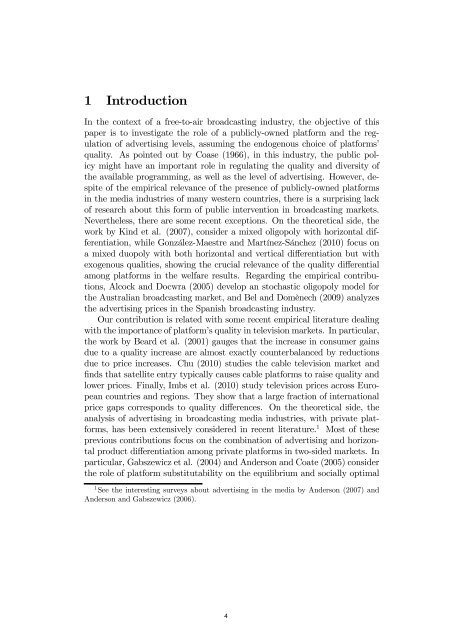You also want an ePaper? Increase the reach of your titles
YUMPU automatically turns print PDFs into web optimized ePapers that Google loves.
1 Introduction<br />
In the context of a free-to-air broadcasting industry, the objective of this<br />
paper is to investigate the role of a publicly-owned platform and the regulation<br />
of advertising levels, assuming the endogenous choice of platforms’<br />
quality. As pointed out by Coase (1966), in this industry, the public policy<br />
might have an important role in regulating the quality and diversity of<br />
the available programming, as well as the level of advertising. However, despite<br />
of the empirical relevance of the presence of publicly-owned platforms<br />
in the media industries of many western countries, there is a surprising lack<br />
of research about this form of public intervention in broadcasting markets.<br />
Nevertheless, there are some recent exceptions. On the theoretical side, the<br />
work by Kind et al. (2007), consider a mixed oligopoly with horizontal differentiation,<br />
while González-Maestre and Martínez-Sánchez (2010) focus on<br />
a mixed duopoly with both horizontal and vertical differentiation but with<br />
exogenous qualities, showing the crucial relevance of the quality differential<br />
among platforms in the welfare results. Regarding the empirical contributions,<br />
Alcock and Docwra (2005) develop an stochastic oligopoly model for<br />
the Australian broadcasting market, and Bel and Domènech (2009) analyzes<br />
the advertising prices in the Spanish broadcasting industry.<br />
Our contribution is related with some recent empirical literature dealing<br />
with the importance of platform’s quality in television markets. In particular,<br />
the work by Beard et al. (2001) gauges that the increase in consumer gains<br />
due to a quality increase are almost exactly counterbalanced by reductions<br />
due to price increases. Chu (2010) studies the cable television market and<br />
finds that satellite entry typically causes cable platforms to raise quality and<br />
lower prices. Finally, Imbs et al. (2010) study television prices across European<br />
countries and regions. They show that a large fraction of international<br />
price gaps corresponds to quality differences. On the theoretical side, the<br />
analysis of advertising in broadcasting media industries, with private platforms,<br />
has been extensively considered in recent literature. 1 Most of these<br />
previous contributions focus on the combination of advertising and horizontal<br />
product differentiation among private platforms in two-sided markets. In<br />
particular, Gabszewicz et al. (2004) and Anderson and Coate (2005) consider<br />
the role of platform substitutability on the equilibrium and socially optimal<br />
1 See the interesting surveys about advertising in the media by Anderson (2007) and<br />
Anderson and Gabszewicz (2006).<br />
2<br />
4

















